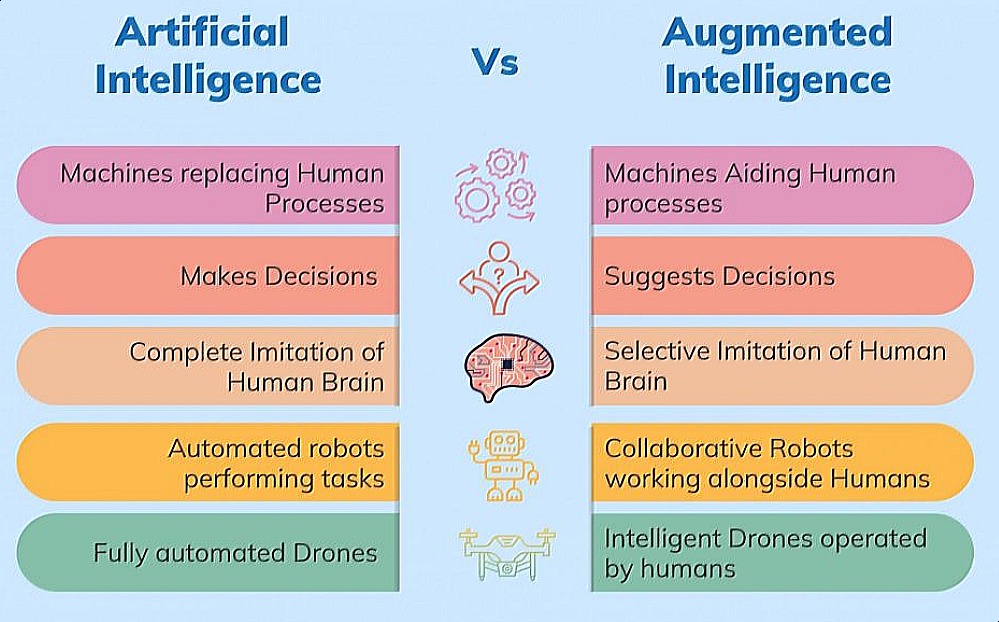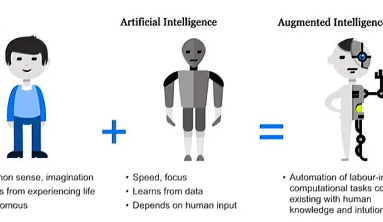Augmented intelligence is designed to enhance, not replace
Augmented intelligence is a subsection of AI machine learning developed to enhance human intelligence rather than operate independently of or outright replace it. It’s designed to do so by improving human decision-making and, by extension, actions taken in response to improved decisions.
How does augmented intelligence work?
Unlike the traditional view of AI as an autonomous system, operating without the need for human involvement, augmented intelligence uses machine learning and deep learning to provide humans with actionable data.
As a reminder, machine learning describes an AI system’s ability to learn and improve from experience without additional programming. Natural language processing, which allows a computer to identify the human language, is an example of machine learning. And deep learning, sometimes referred to as deep neural learning, describes an AI process that mimics the human brain’s ability to process data and see patterns, much to the felicity of data scientists staring down massive data sets (see below).
What is augmented intelligence used for?
If you’ve used Alexa, Siri, or another virtual assistant, you’ve used augmented intelligence. Virtual assistants don’t make decisions for you. Instead, they provide the data you need when you need it. When it comes to big data, think of augmented intelligence as virtual assistants for data scientists, who would otherwise be faced with a big, big problem.
Augmented intelligence: a solution to the big-data problem
The Internet of Things (IoT), cloud storage, and big data have allowed for the collection, storage, and analysis of data as never before. The sheer bulk of this data is mind-boggling: the International Data Corporation estimates by 2020, the “digital universe” will contain over 5,200 gigabytes of data for every person on the planet, for a total of 40 trillion gigabytes of data points.
Big data offers insight into everything from marketing and customer preferences to predictive analytics of scientific, medical, and geopolitical issues. However, a big problem with big data is that its sheer size makes unaided mining and analysis, among other tasks, incredibly difficult. Augmented intelligence offers data scientists a solution to help them sift through such vast amounts of data: its deep learning capabilities can pull patterns out of gigabytes of data that interpreters might otherwise miss due to the sheer size of the set.
Without augmented intelligence, processing big data would take a long, long time - sometimes years, depending on data set size - and all the while crucial data patterns would be lost to human oversight. For this reason, augmented intelligence is at the center of the blossoming fields of data analytics and predictive data.
How is augmented intelligence different from artificial intelligence?
Many of the tools and strategies used in augmented intelligence are used in the broader world of AI, including machine learning and deep learning. So how does augmented intelligence differ from AI? To start, it’s helpful to understand what AI is.

What is artificial intelligence?
AI is popularly thought to mean any system of machine learning that duplicates or improves upon human intelligence. That’s not strictly true. AI, or machine intelligence, does describe algorithms capable of making intelligent decisions, but such software rarely “thinks” in the way humans do.
Reactive machines monitor data, sensors, and other input, making decisions based on that input. They have no memory, so they cannot learn. Instead, they make all decisions based on criteria decided by their programmer in response to specific circumstances.
Limited memory AI retains data and can learn from past experiences. AI systems in autonomous vehicles require limited-memory AI, as does natural language processing.
The popular notion of AI, a machine that is self-aware and understands theory of mind (the ability to recognize one’s own or another’s mental state), is not possible with current technology and is decades away from becoming a reality.
What is the difference between artificial and augmented intelligence?
The key difference between AI and augmented intelligence is one of autonomy. AI is intended to operate without human assistance. Such AI generally operates within very narrow criteria and is often intended to take mundane tasks off human hands. Examples of AI already present in everyday life include email spam filters, plagiarism checkers, and Google’s AI-powered search suggestions.
Many of the obstacles and technological challenges standing in the way of true AI are not issues for augmented intelligence, as augmented intelligence’s machine learning does not have to take part in any decision-making process. Instead, augmented intelligence analyzes data, sees patterns, and reports those patterns to users, allowing human intelligence to take over.
An everyday example would be the viewing recommendations provided by a streaming video service. AI algorithms analyze user viewing habits and recommend additional viewing based on those habits. It’s up to viewers, however, to decide whether to act on algorithm suggestions.
Augmented intelligence applications
Augmented intelligence has been part of our lives for years (one could argue that the abacus, and later the calculator, are primitive examples of augmented intelligence, in that they allow faster processing of data and decisions based on that data). As the IoT and smart object connectivity expands, we can expect to see augmented intelligence in almost all aspects of life.
How is augmented intelligence used in applications?
Augmented intelligence and deep learning have applications in any industry that mines big data for patterns and predictive indicators. Examples include the following:
- Online stores using data analytics to predict customer preferences
- Political think tanks using big data analytics to identify undecided voters
- medical analysis of case files to identify efficient treatment options
- Factory automation is overseen by human employees
- Virtual customer service assistance based on natural language processing
- Mobile video games using surrounding environments and data to create augmented reality events, superimposing computer-generated images on smartphone camera screens
- Virtual tutors and instructors for distance education
- Airplane and drone autopilot systems (pilots are required for takeoff, landing, and unexpected events while autopilots handle the mundane tasks associated with flight)
- Investment and financial applications monitoring and identifying stock market patterns
- Predictive maintenance of factory equipment based on past data
What are the benefits of augmented intelligence applications?
Augmented intelligence improves human decision-making both by handling large amounts of data that would overwhelm a human decision-maker, and by removing factors that can color or misinterpret data, including bias, fatigue, and distraction. (It is important to remember, however, that humans can inject bias into augmented intelligence algorithms during system creation.)
When used together properly, augmented intelligence and human intelligence are greater than the sum of their parts. An IBM report, Augmented Intelligence Requires Human Direction, references a clinical study that offers an excellent example. In the study, an AI system had a 7.5 percent error rate when detecting lymph node cancer cells while human pathologists had a 3.5 percent error rate. When input from both the AI system and pathologists was combined, however, the error rate dropped to 0.5 percent.
Augmented intelligence offers a chance to make more accurate data-driven decisions in science, business, and everyday life. It represents a symbiotic relationship between man and machine. Rather than replacing us, augmented intelligence helps heighten our decision-making ability—and by extension, our intelligence too.






